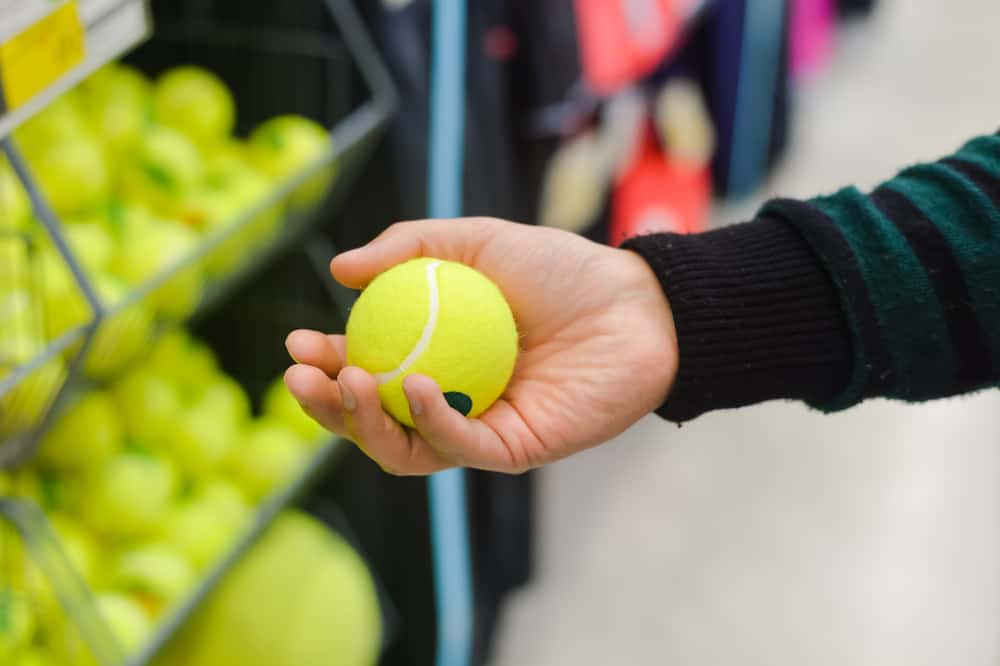In this article, we’ll cover everything you need to know about tennis balls and air pressure. If you’ve ever wondered why tennis balls are pressurized, read on for a comprehensive guide on the topic.
POINTS
- Tennis balls are pressurized to have more bounce, spin response, and speed.
- The pressure within a tennis ball is measured in psi (per square inch).
- Pressurized tennis balls benefit all types of players by being more lightweight and easier to hit.
- While practice with pressurized balls is beneficial, old or flat balls can be checked and re-pressurized with the help of a Tennis Ball Saver or pressure tube.
Pressurized tennis balls have three major benefits: more bounce, more spin response, and more speed. The pressure within the can holding the tennis balls measures 14 psi, allowing them to maintain their proper pressure.
Pressureless tennis balls are heavier than pressurized ones, so those that are pressurized spin with greater response. This pressure also allows them to travel at high rates of speed as well.
Using a pressurized tennis ball versus a pressureless tennis ball is beneficial when hosting a major tennis match due to its bounce rate and speed. The pressure within also allows the tennis balls to maintain their lightweight nature, making them easier to hit and creating a more exciting match.
The science behind pressurized tennis balls
The height to which a pressurized tennis ball will bounce depends on the air pressure within the ball itself. Tennis balls are created to have more internal air pressure than external air pressure.
When the tennis ball is taken out of the pressurized can, there is actually more air pushing on the inside of the ball than on the outside of it. Air can also escape through the ball to the outside at a slow pace, causing it to lose its bounce.
The air pressure that is normal for us is called “ambient air pressure,” and it measures 14.7 psi (per square inch). The pressure within the tennis ball is at 12 psi. These numbers equate to 26.7 psi.
This number is the total psi amount within the tennis ball. The tennis ball is measured in psi (per square inch). It is calculated by using the formula for the volume of a sphere: V = 4/3 π r³. In this case, V equals volume, and r equals radius.
The felt outside the tennis ball plays four major roles in its creation: durability, control, speed, and bounce. The felt wraps around the rubber beneath the outer felt material, allowing the ball to last longer. It also increases the ability of the player to control the tennis ball and the spin it produces. The felt also slows the rate of speed at which the ball travels and gives it the ability to bounce just right.
The benefits of pressurized tennis balls
The correct pressure within a pressurized tennis ball can increase the playability of the tennis match it is in. If a tennis ball had no pressure within its hollow core, it would feel flat to tennis players. This would interrupt or stop gameplay altogether, as the ball wouldn’t be able to travel back and forth across the court.
Athletes benefit more from pressurized tennis balls due to the higher amount of air pressure within them. Pressurized tennis balls are more lightweight and have increased levels of bounce in comparison to pressureless tennis balls. These factors make it easier for tennis players to hit the balls with their racquets, making for a more exciting match.
Pressurized tennis balls can also improve the practice of a beginner or a recreational player, as these are the same types of balls used in professional tournaments. While some believe that pressureless balls are best for beginners, the balls are actually heavier, giving the player a false sense of how to use their racquet in a real match setting.
If you practice with heavy, pressureless tennis balls, you will be thrown off when a pressurized ball is introduced instead. Since pressurized tennis balls are standard on the professional level, getting accustomed to them on your own will only benefit you in the future.
The challenges of maintaining pressurized tennis balls
One of the main reasons pressurized tennis balls lose air is a leak from the outside of their rubber core. Every time a tennis ball comes in contact with the racquet, the hit releases pressure within the ball. This causes it to go flat over time.
If the temperature of the area where the tennis ball is is extremely hot, the energy of the molecules inside it will move quickly, causing the ball to bounce higher. If the temperature is lower, the opposite effect occurs.
Both players and coaches can check the pressure of a tennis ball using a tool called a Tennis Ball Saver. To do so, just place the tennis ball in the Tennis Ball Saver can and twist the lid. This action increases the pressure within the tube, thus increasing the pressure of the tennis balls.
There is also a device called a “pressure tube” available for this purpose. It consists of a slim plastic tube that measures tennis balls’ psi. It also allows you to bring your balls back to the correct psi when necessary.
The manufacturers of tennis balls evaluate several aspects to ensure the proper quality of each product, from acclimatization and decompression to deformation testing, rebound testing, and color observation. These detailed checks evaluate the key metrics, including proper air pressure levels, that differentiate a good tennis ball from a low-quality one. Tennis balls have optimal pressure when they’re brand new, but this declines over time, presenting the need for added pressure in old tennis balls.
FAQ
What are the benefits of using a pressurized tennis ball?
When you use a pressurized tennis ball, you will experience more bounce and speed when sending shots across the court. Additionally, you can get more spin responses after hitting a pressurized tennis ball than you would with a pressureless ball.
Do athletes benefit from pressurized tennis balls?
Yes, athletes certainly benefit from pressurized tennis balls. They gain a competitive edge in matches and tournaments after serving a pressurized ball across the court with lightning speed. During practice, pro players can simulate a real tournament environment.
What is the Tennis Ball Saver?
The Tennis Ball Saver is a tool to check and increase the pressure levels of a tennis ball. To use it, place your tennis ball in the Tennis Ball Saver can and twist the lid. As the pressure in the tube increases, so will the inside of the ball.
Conclusion
As you can see, pressurized tennis balls can benefit all types of tennis players. From beginner to expert, the speed, bounce, and easy contact with the racquet make it easy to reach your full potential on the court. Professional athletes, in particular, can gain a competitive edge against their opponents with swift shots and accurate serves.
If you want to improve your game, investing in high-quality, pressurized tennis balls is essential. By simulating the environment of a real tennis match, you can practice your techniques and shots to improve your muscle memory for the future. Whether you’re practicing by yourself or facing an opponent, ensure your tennis balls are pressurized for the best results.
As always, get out there and practice, and keep reading more articles on our blog if you found this information helpful!
 Written by Mark Sampson
Written by Mark Sampson